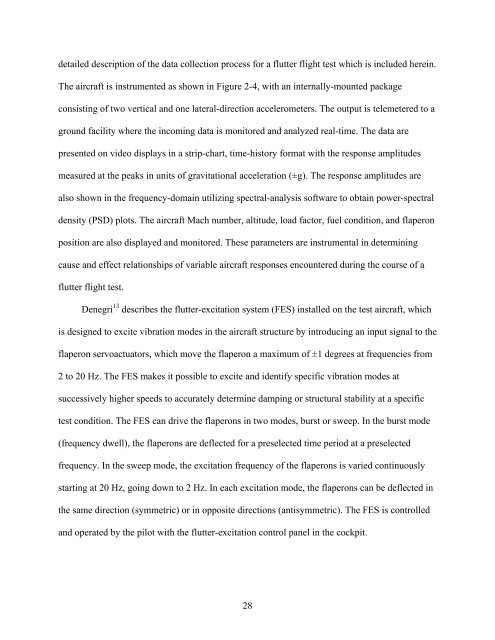university of florida thesis or dissertation formatting template
university of florida thesis or dissertation formatting template
university of florida thesis or dissertation formatting template
Create successful ePaper yourself
Turn your PDF publications into a flip-book with our unique Google optimized e-Paper software.
detailed description <strong>of</strong> the data collection process f<strong>or</strong> a flutter flight test which is included herein.<br />
The aircraft is instrumented as shown in Figure 2-4, with an internally-mounted package<br />
consisting <strong>of</strong> two vertical and one lateral-direction accelerometers. The output is telemetered to a<br />
ground facility where the incoming data is monit<strong>or</strong>ed and analyzed real-time. The data are<br />
presented on video displays in a strip-chart, time-hist<strong>or</strong>y f<strong>or</strong>mat with the response amplitudes<br />
measured at the peaks in units <strong>of</strong> gravitational acceleration (±g). The response amplitudes are<br />
also shown in the frequency-domain utilizing spectral-analysis s<strong>of</strong>tware to obtain power-spectral<br />
density (PSD) plots. The aircraft Mach number, altitude, load fact<strong>or</strong>, fuel condition, and flaperon<br />
position are also displayed and monit<strong>or</strong>ed. These parameters are instrumental in determining<br />
cause and effect relationships <strong>of</strong> variable aircraft responses encountered during the course <strong>of</strong> a<br />
flutter flight test.<br />
Denegri 13 describes the flutter-excitation system (FES) installed on the test aircraft, which<br />
is designed to excite vibration modes in the aircraft structure by introducing an input signal to the<br />
flaperon servoactuat<strong>or</strong>s, which move the flaperon a maximum <strong>of</strong> ±1 degrees at frequencies from<br />
2 to 20 Hz. The FES makes it possible to excite and identify specific vibration modes at<br />
successively higher speeds to accurately determine damping <strong>or</strong> structural stability at a specific<br />
test condition. The FES can drive the flaperons in two modes, burst <strong>or</strong> sweep. In the burst mode<br />
(frequency dwell), the flaperons are deflected f<strong>or</strong> a preselected time period at a preselected<br />
frequency. In the sweep mode, the excitation frequency <strong>of</strong> the flaperons is varied continuously<br />
starting at 20 Hz, going down to 2 Hz. In each excitation mode, the flaperons can be deflected in<br />
the same direction (symmetric) <strong>or</strong> in opposite directions (antisymmetric). The FES is controlled<br />
and operated by the pilot with the flutter-excitation control panel in the cockpit.<br />
28
















